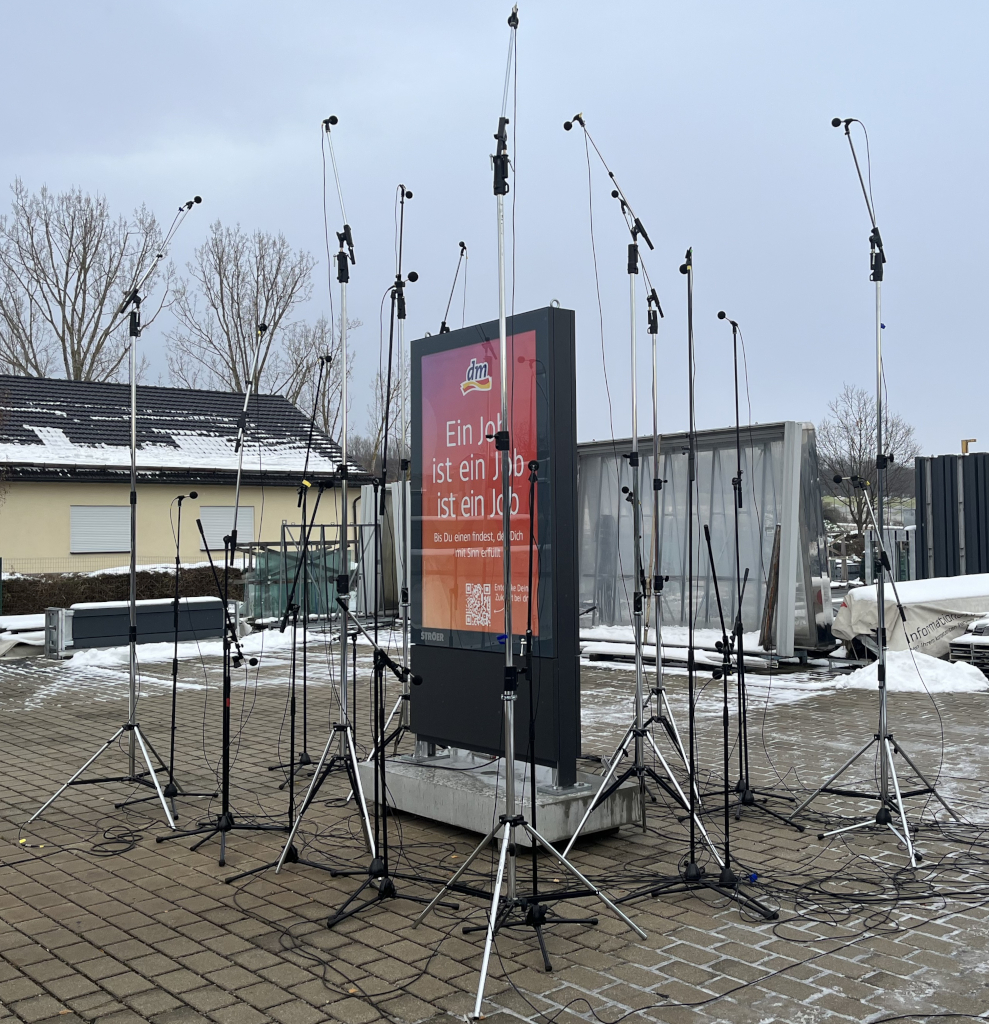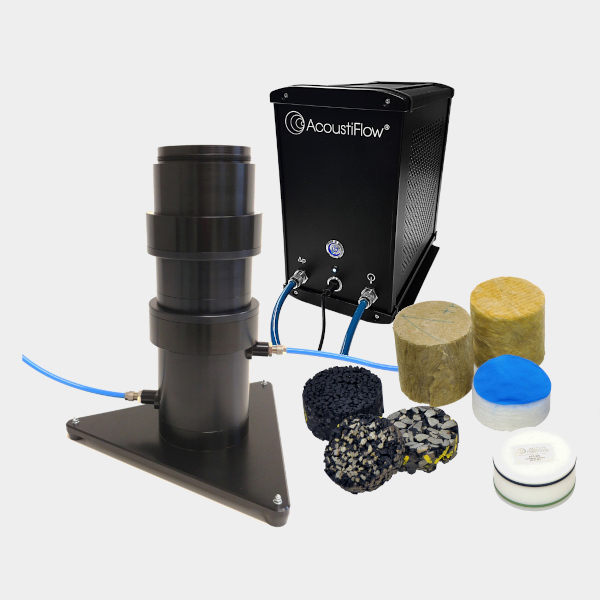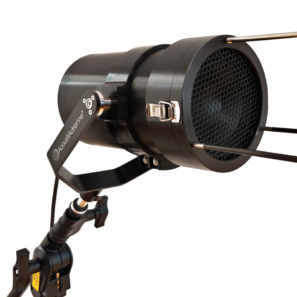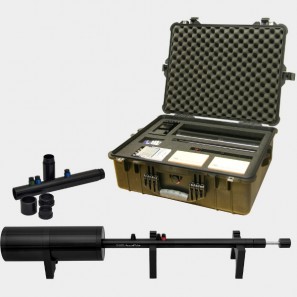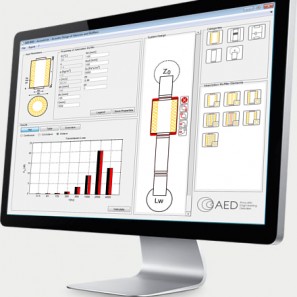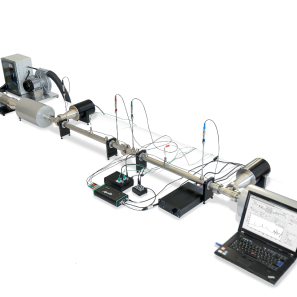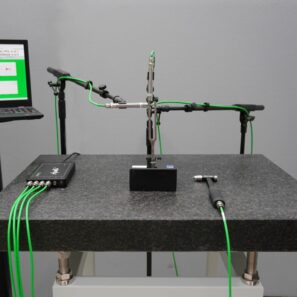Principle of measurements of sound power
The sound power indicates the sound emission of a machine regardless of its installation conditions and the prevailing ambient conditions on site, even if the basic measured variables determined for this purpose are different and can be measured in different ways.
The DIN EN ISO 3740 series of standards is based on the measurement of the sound pressure level in the far field, i.e. in the direct field (on an imaginary enveloping surface) or in the diffuse field (at a distance greater than the reverberation radius) of the sound source to be examined. In contrast, the DIN EN ISO 9614 series of standards determines the sound power based on the measured sound intensity in the near field (on an imaginary enveloping surface) of the test object.
Generally, the sound pressure level is measured using measuring microphones in conjunction with a multi-channel data acquisition unit; in rare cases, sound level meters are also used. In general, the sound intensity is measured using a sound intensity probe. Usually, an application-oriented analysis software with an intuitive graphical user interface enables the measurement signals to be analyzed and the sound power to be determined in accordance with standards.
Parameters of sound power
The measuring system for sound power allows the measurement of, among others, the following, mostly frequency-dependent parameters and associated acoustic quantities:
- sound pressure level at individual microphones around the sound source under investigation as well as calculated energetic mean values in conjunction with various time and frequency weightings, e.g. LAF, LAeq, LCF, LCeq
- sound pressure level on measurement surface Lm
- measurement surface value of imaginary enveloping surface LS
- sound intensity level LI
- sound power level Lw
- atmospheric pressure/temperature correction K0
- background noise correction K1
- ambient correction K2
Components of measuring system for sound power
The components of the measurement system for sound power include among others:
Technical Data (Excerpt)
Measuring microphones and accessories
- measuring microphone 1/2“, class 1
- IEPE measuring microphone 1/2″ + preamplifier
- frequency range: 3,5 Hz – 20 kHz
- dynamic range: 15 dB(A)-135 dB(A)
- BNC connector
- TEDS
- measuring microphone 1/4“, class 1
- IEPE measuring microphone 1/4″
- 4 mA IEPE/ICP required
- UNF10-32/BNC adapter
- microphone calibrator, class 1
- for measuring microphones 1/2“
- PTB approval, class 1
- 1 kHz
- switchable between 94 dB / 114 dB
- adapter for measuring microphones 1/4“ available
- other available accessories
- microphone fitting
- tripod for microphones
- connecting cable microphone-data acquisition unit
- windshield for microphones
- et al.
Sound intensity probes and accessories
- sound intensity probe 1/2″
- 2 IEPE measurement microphones 1/2″ + preamplifier
- spacer 12 mm und 25 mm
- remote control for analysis software Samurai
- connection cable 1.5 m with splitter
- case
- special version with USB set for use with NoisePAD™ available (see measuring system for room acoustics and building acoustics)
- calibrator sound intensity probe
- adapter for sound intensity probe 1/2“ and 1/4”
- requires external generator (e.g. via analysis software Samurai with Apollo Box lt data acquisition unit and output adapter)
- other available accessories
- spacer 6 mm, 16,5 mm, 20 mm und 50 mm
- telescopic extension 3.2 m
- connecting cable sound intensity probe-data acquisition unit
- windshield for intensity probes
- et al.
Modular, scalable multi-channel data acquisition unit
- Soundbook MK2
- universally applicable 2-/4- or 8-channel measuring system (incl. PC) for acoustics, vibration and general engineering measurements
- Panasonic Toughbook CF-19 with robust magnesium housing and convertible bright TFT display
- combination of maximum precision with a high number of channels and signal bandwidth
- 2, 4 or 8 measurement channels, powerful 24-bit A/D converter, phantom power / IEPE power supply, frequency range up to 80 kHz
- expandable with Soundbook MK2 expander to up to 40 synchronously operating measurement channels
- numerous other interfaces
- effective protection against heat, cold, rain, dust, vibration and heavy impacts
- LEMO7 or BNC input jacks
- moderate energy consumption
- PTB type approval 21.21 / 13.05, only PC-based verifiable analyzer
- Soundbook MK2 Expander
- flexible, portable 8-channel sound and vibration meter (requires additional PC) with high signal bandwidth, high dynamic range and integrated sensor power supply
- 8 measuring channels with selectable variants with LEMO7 or BNC connectors, powerful 24-bit A/D converter, phantom power supply / IEPE power supply, frequency range up to 80 kHz
- additionally 8 slow channels, 2 tacho and trigger channels, synchronization port and AUX port for universal use of the device
- can be expanded with additional modules via HUB to up to 40 synchronous measuring channels; coupling/synchronization with Soundbook MK2 also possible
- reduction of data volume through individually adjustable sampling rate per channel
- Apollo Box lt
- cost-effective 2-/4-/8- or 16-channel sound and vibration analyzer in a robust, high-quality aluminum housing with USB interface (requires additional PC)
- 2, 4, 8, or 16 measurement channels, powerful 24-bit A/D converter, IEPE power supply, frequency range up to 20 kHz
- additional trigger/tacho and output channels, frequency range up to 20 kHz
- BNC/LEMO/NIM CAMAC connectors
- particularly low power consumption enables operation with a tablet PC
- multiple Apollo lt modules can be synchronized with each other; sample rate can be individually adjusted for each channel
Multifunctional data acquisition and analysis software Samurai
- module Sound level meter
- module Fractional octaves
- octave bands
- third octaves bands
- 1/24 octaves bands
- module Sound intensity
- module Sound power for determining the sound power by measuring the sound pressure level on an imaginary enveloping surface or in a diffuse sound field in accordance with DIN EN ISO 3744, DIN EN ISO 3745 and DIN EN ISO 3746
- module Sound power for determining the sound power by measuring the sound intensity level in accordance with the DIN EN ISO 9614 series of standards (DIN EN ISO 9614-1, DIN EN ISO 9614-2 and DIN EN ISO 9614-3)
- module Sound field mapping for generation of color mappings of sound intensity (scanning method)
- module Synchronous FFT for determining vibration or sound spectra of rotating units at high background noise level by speed-synchronous averaging of complex FFT blocks
- module Virtual tachometer fordetermination of rotational speed and order analysis of rotating parts using the narrow-band spectrum of a sensor (e.g. microphone or accelerometer) if the use of a laser tachometer is not possible and no speed pulses are available (prerequisite: rotational frequency or harmonics thereof are sufficiently reflected in the spectrum used by local maxima)
- et al.
Training and Evaluation
We offer you and your employees training in the handling and operation of measurement technology and analysis software and create defined evaluation scripts upon request (e.g. in xlsx format).
Design of acoustic test benches according to standards, implementation of software solutions
Die Gesellschaft für Akustikforschung also supports you in the design of acoustic test benches (e.g. end-of-line tests) according to specific standards and/or the implementation of customized software solutions for you.
Calibration
Furthermore, we offer you the option of having the input channels of the data acquisition unit calibrated by a DAkkS-certified body. Thereby, a combined test by free-field and pressure chamber calibration of sound level meters according to DIN EN 61672-3 with acoustic calibration of the amplitude frequency response in the free field from 125 Hz to 20 kHz (free-field calibration) and in the pressure chamber from 31.5 Hz to 100 Hz (pressure chamber calibration) is applied.
